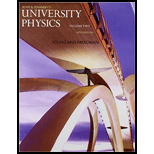
University Physics with Modern Physics, Volume 2 (Chs. 21-37); Mastering Physics with Pearson eText -- ValuePack Access Card (14th Edition)
14th Edition
ISBN: 9780134265414
Author: Hugh D. Young, Roger A. Freedman
Publisher: PEARSON
expand_more
expand_more
format_list_bulleted
Question
Chapter 41, Problem 41.23E
(a)
To determine
The angular speed the electron as a classical spherical object must possess to produce a spin
(b)
To determine
The speed of the electron’s equator and what does the result suggest about the validity of the model.
Expert Solution & Answer
Want to see the full answer?
Check out a sample textbook solution
Students have asked these similar questions
Can someone help me with this question. Thanks.
Can someone help me with this question. Thanks.
Can someone help me with this question. Thanks.
Chapter 41 Solutions
University Physics with Modern Physics, Volume 2 (Chs. 21-37); Mastering Physics with Pearson eText -- ValuePack Access Card (14th Edition)
Ch. 41.1 - Prob. 41.1TYUCh. 41.2 - Prob. 41.2TYUCh. 41.3 - Prob. 41.3TYUCh. 41.4 - In this section we assumed that the magnetic field...Ch. 41.5 - In which of the following situations is the...Ch. 41.6 - Prob. 41.6TYUCh. 41.7 - Prob. 41.7TYUCh. 41.8 - Prob. 41.8TYUCh. 41 - Prob. 41.1DQCh. 41 - Prob. 41.2DQ
Ch. 41 - Prob. 41.3DQCh. 41 - Prob. 41.4DQCh. 41 - Prob. 41.5DQCh. 41 - Prob. 41.6DQCh. 41 - Prob. 41.7DQCh. 41 - In the ground state of the helium atom one...Ch. 41 - Prob. 41.9DQCh. 41 - Prob. 41.10DQCh. 41 - Prob. 41.11DQCh. 41 - Prob. 41.12DQCh. 41 - Prob. 41.13DQCh. 41 - Prob. 41.14DQCh. 41 - Prob. 41.15DQCh. 41 - Prob. 41.16DQCh. 41 - Prob. 41.17DQCh. 41 - Prob. 41.18DQCh. 41 - Prob. 41.19DQCh. 41 - Prob. 41.20DQCh. 41 - Prob. 41.21DQCh. 41 - Prob. 41.22DQCh. 41 - Prob. 41.23DQCh. 41 - Prob. 41.1ECh. 41 - Prob. 41.2ECh. 41 - Prob. 41.3ECh. 41 - Prob. 41.4ECh. 41 - Prob. 41.5ECh. 41 - Prob. 41.6ECh. 41 - Prob. 41.7ECh. 41 - Prob. 41.8ECh. 41 - Prob. 41.9ECh. 41 - Prob. 41.10ECh. 41 - Prob. 41.11ECh. 41 - Prob. 41.12ECh. 41 - Prob. 41.13ECh. 41 - Prob. 41.14ECh. 41 - Prob. 41.15ECh. 41 - Prob. 41.16ECh. 41 - Prob. 41.17ECh. 41 - Prob. 41.18ECh. 41 - A hydrogen atom in a 3p state is placed in a...Ch. 41 - Prob. 41.20ECh. 41 - Prob. 41.21ECh. 41 - Prob. 41.22ECh. 41 - Prob. 41.23ECh. 41 - Prob. 41.24ECh. 41 - Prob. 41.25ECh. 41 - Prob. 41.26ECh. 41 - Prob. 41.27ECh. 41 - Prob. 41.28ECh. 41 - Prob. 41.29ECh. 41 - (a) Write out the ground-state electron...Ch. 41 - Prob. 41.31ECh. 41 - Prob. 41.32ECh. 41 - Prob. 41.33ECh. 41 - Prob. 41.34ECh. 41 - Prob. 41.35ECh. 41 - Prob. 41.36ECh. 41 - Prob. 41.37ECh. 41 - Prob. 41.38ECh. 41 - Prob. 41.39PCh. 41 - Prob. 41.40PCh. 41 - Prob. 41.41PCh. 41 - Prob. 41.42PCh. 41 - Prob. 41.43PCh. 41 - Prob. 41.44PCh. 41 - Prob. 41.45PCh. 41 - Prob. 41.46PCh. 41 - Prob. 41.47PCh. 41 - Prob. 41.48PCh. 41 - Prob. 41.49PCh. 41 - Prob. 41.50PCh. 41 - Prob. 41.51PCh. 41 - Prob. 41.52PCh. 41 - Prob. 41.53PCh. 41 - Prob. 41.54PCh. 41 - Prob. 41.55PCh. 41 - Prob. 41.56PCh. 41 - Prob. 41.57PCh. 41 - Effective Magnetic Field. An electron in a...Ch. 41 - Prob. 41.59PCh. 41 - Prob. 41.60PCh. 41 - Prob. 41.61PCh. 41 - Prob. 41.62PCh. 41 - Prob. 41.63PCh. 41 - Prob. 41.64PCh. 41 - Prob. 41.65PCh. 41 - Prob. 41.66PCh. 41 - Prob. 41.67PCh. 41 - Prob. 41.68CPCh. 41 - Prob. 41.69CPCh. 41 - Prob. 41.70PPCh. 41 - Prob. 41.71PPCh. 41 - Prob. 41.72PPCh. 41 - Prob. 41.73PP
Knowledge Booster
Similar questions
- Identical rays of light enter three transparent blocks composed of different materials. Light slows down upon entering the blocks.arrow_forwardFor single-slit diffraction, calculate the first three values of (the total phase difference between rays from each edge of the slit) that produce subsidiary maxima by a) using the phasor model, b) setting dr = 0, where I is given by, I = Io (sin (10) ². 2arrow_forwardA capacitor with a capacitance of C = 5.95×10−5 F is charged by connecting it to a 12.5 −V battery. The capacitor is then disconnected from the battery and connected across an inductor with an inductance of L = 1.55 H . (D)What is the charge on the capacitor 0.0235 s after the connection to the inductor is made? Interpret the sign of your answer. (e) At the time given in part (d), what is the current in the inductor? Interpret the sign of your answer. (f) Atthe time given in part (d), how much electrical energy is stored in the capacitor and how much is stored in the inductor?arrow_forward
arrow_back_ios
SEE MORE QUESTIONS
arrow_forward_ios
Recommended textbooks for you
 Modern PhysicsPhysicsISBN:9781111794378Author:Raymond A. Serway, Clement J. Moses, Curt A. MoyerPublisher:Cengage Learning
Modern PhysicsPhysicsISBN:9781111794378Author:Raymond A. Serway, Clement J. Moses, Curt A. MoyerPublisher:Cengage Learning University Physics Volume 3PhysicsISBN:9781938168185Author:William Moebs, Jeff SannyPublisher:OpenStax
University Physics Volume 3PhysicsISBN:9781938168185Author:William Moebs, Jeff SannyPublisher:OpenStax Principles of Physics: A Calculus-Based TextPhysicsISBN:9781133104261Author:Raymond A. Serway, John W. JewettPublisher:Cengage Learning
Principles of Physics: A Calculus-Based TextPhysicsISBN:9781133104261Author:Raymond A. Serway, John W. JewettPublisher:Cengage Learning Physics for Scientists and Engineers with Modern ...PhysicsISBN:9781337553292Author:Raymond A. Serway, John W. JewettPublisher:Cengage Learning
Physics for Scientists and Engineers with Modern ...PhysicsISBN:9781337553292Author:Raymond A. Serway, John W. JewettPublisher:Cengage Learning
 Classical Dynamics of Particles and SystemsPhysicsISBN:9780534408961Author:Stephen T. Thornton, Jerry B. MarionPublisher:Cengage Learning
Classical Dynamics of Particles and SystemsPhysicsISBN:9780534408961Author:Stephen T. Thornton, Jerry B. MarionPublisher:Cengage Learning

Modern Physics
Physics
ISBN:9781111794378
Author:Raymond A. Serway, Clement J. Moses, Curt A. Moyer
Publisher:Cengage Learning

University Physics Volume 3
Physics
ISBN:9781938168185
Author:William Moebs, Jeff Sanny
Publisher:OpenStax

Principles of Physics: A Calculus-Based Text
Physics
ISBN:9781133104261
Author:Raymond A. Serway, John W. Jewett
Publisher:Cengage Learning

Physics for Scientists and Engineers with Modern ...
Physics
ISBN:9781337553292
Author:Raymond A. Serway, John W. Jewett
Publisher:Cengage Learning


Classical Dynamics of Particles and Systems
Physics
ISBN:9780534408961
Author:Stephen T. Thornton, Jerry B. Marion
Publisher:Cengage Learning